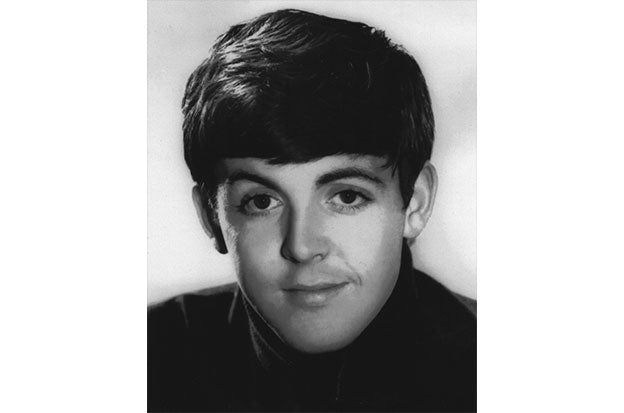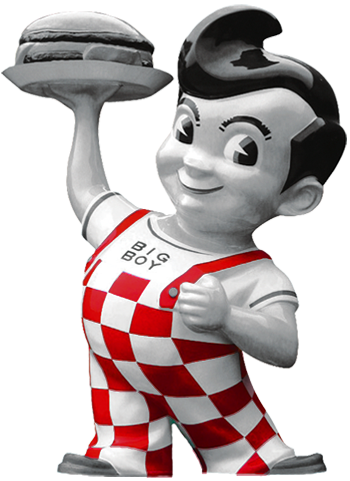Paul McCartney
 Paul McCartney in a press photo
Paul McCartney in a press photo
Born in Liverpool, Sir James Paul McCartney, was the founder, co-singer/songwriter, and bass guitarist for a band called The Beatles. The compilation album 1 can summarize the extent of their popularity. Released in 2000, it features all 27 of their songs to chart #1 in the U.S. or U.K.
In 1965, the FAB 4 requested to see a real American diner during their second U.S. tour and Bob’s Big Boy Burbank was lucky enough to fill this need to become a part of Beatlemania.
 Paul as a youth
Paul as a youth
Labeled “the cute Beatle” by the mainstream press, McCartney did require his personal approval before any photographs of him were published. He should be known as “the voice,” specifically his belting power; he had a wide tenor vocal range spanning over four to five octaves.
 The voice of the Beatles
The voice of the Beatles
Little Richard was a childhood idol. Early in the Beatles career, Paul would lead covers of "Long Tall Sally" and "Kansas City/Hey, Hey, Hey, Hey". Upon seeing Elvis in an ad for "Heartbreak Hotel" in 1956, Paul would remember saying, "The Messiah has arrived!" His self-titled album to follow was "so fantastic we played it endlessly trying to learn it all. Everything we did was based on that album." Buddy Holly was another huge, third American influence. Paul eventually bought the publishing rights to Holly's song catalogue in 1976 as well as produced and hosted The Real Buddy Holly Story (1985).
The early formation of the band was taking place as early as 1957, but their thirteen full-length albums (one a double) happened in just a mind-bending seven years: Please Please Me (1963), With the Beatles (1963), A Hard Day's Night (1964), Beatles for Sale (1964), Help! (1965), Rubber Soul (1965), Revolver (1966), Sgt. Pepper's (1967), Magical Mystery Tour (1967), The White Album (1968), Yellow Submarine (1969), Abbey Road (1969), and Let It Be (1970).
"I Want to Hold Your Hand", "We Can Work It Out", and "A Day in the Life" are three of the greatest Lennon-McCartney collaborations. The latter being regarded as one of the finest works in the history of music.
Some of McCartney’s greatest songs are: "I Saw Her Standing There", "Things We Said Today", "Yesterday", "Drive My Car", "I’m Looking Through You", "Paperback Writer", "Eleanor Rigby", "Here There and Everywhere", "For No One", "Penny Lane", "I’ll Follow the Sun", "Helter Skelter", "Blackbird", "Get Back", "Let It Be", "Abbey Road" (Medley), and "Hey Jude".
"Hey Jude" topped U.S. charts for nine weeks, longer than any Beatles single. The simple start, with just McCartney on piano vocals, transforms into a four-minute coda. The "Na-na-na na" chant has become one of the greatest audience participations in human history. It is also the favorite Beatles song of Bob’s Big Boy Burbank Hall-of-Famer Danny Trejo, who claimed it was responsible for a prison riot.
The "Abbey Road" (Medley) is a tapestry of eight unfinished songs stitched together to create a greater whole, and was largely Paul’s invention working with producer George Martin. The result was an epic work of art ending with the couplet, “And in the end, the love you take is equal to the love you make.” The B-side Medley’s beauty and influence cannot be overstated.
 1965 Hollywood Bowl concert poster
1965 Hollywood Bowl concert poster
The Beatles stormed Southern California after their release of Help! (1965). They had four nights off where they stayed in Benedict Canyon from August 23rd to 27th. On the night of August 27th, just days after dining at Bob’s Big Boy Burbank, they would meet their idol Elvis at his home in Bel Air. After playing San Diego on August 28th, they played The Hollywood Bowl consecutive nights, August 29th and 30th.
Following the breakup of the Beatles, Paul released “Maybe I’m Amazed” on his self-titled solo debut album, McCartney (1970). He wrote the song for his wife Linda and it is considered one of his finest love songs.
 Paul McCartney in Scotland
Paul McCartney in Scotland
His next album release Ram (1971) "Uncle Albert / Admiral Halsey" became his first #1 hit in America as a solo artist. The energetic, vocal-thrashing “Monkberry Moon Delight” and the strong finish of "Backseat of My Car", make this Paul’s most "complete" Beatles solo album.
His band Wings started to take flight with the song "Jet" and the titular single from Band on the Run (1973). "Let ‘Em In" comes from Wings at the Speed of Sound (1976). McCartney finally starts to play five Beatles songs on tour with Wings and releases a live triple album Wings over America (1976); it hits #1 on the U.S. charts.
 Album cover art for CHOBBA B CCCP
Album cover art for CHOBBA B CCCP
Similar in concept to John Lennon’s Rock 'n' Roll, Paul McCartney releases an album in Russia called CHOBBA B CCCP (1988). Full of 1950’s American covers, the selections present a sound example of McCartney’s roots. "Lucille" originally recorded by Little Richard, "Twenty Flight Rock" originally recorded in a rockabilly flavor by Eddie Cochran, "Ain’t That a Shame" by Fats Domino, and two made popular by Elvis, "That’s All Right Mama" and "Just Because".
 Paul eating a hamburger
Paul eating a hamburger
While Paul McCartney went totally vegetarian in 1975, he is not vegan; eggs have been always been a big part of his life and diet. Arguably his greatest song “Yesterday” was originally titled “Scrambled Eggs”. Paul actually prefers his eggs over easy though. With breakfast served anytime at Bob’s Big Boy Burbank, Paul is likely to have indulged and ordered eggs when visiting that fateful night in 1965.
 Paul in a '65 Mini Cooper
Paul in a '65 Mini Cooper
Paul’s car collection is a tour de force. At one point in time he’s owned a 1964 Aston Martin DB5, 1965 Mini Cooper S DeVille, and a 1973 Rolls-Royce Corniche. He got a 2003 Chevrolet C5 Corvette when he moved to LA.
Paul is the only Beatle to have been nominated for an Oscar in his own right. His two Oscar-nominations for Best Original Song were titular songs from the films, "Live and Let Die" in 1974, and "Vanilla Sky" in 2001.
In 1997, Queen Elizabeth II knighted Paul (yes, Sir Paul!) for his “services to music.”
The Beatles were inducted into the Rock and Roll Hall of Fame in 1988 and Paul as a solo artist in 1999.
Paul McCartney’s star on the Hollywood Walk of Fame is at 1750 Vine Street. The Beatles star is at 7080 Hollywood Blvd.
 Sir Paul McCartney
Sir Paul McCartney
